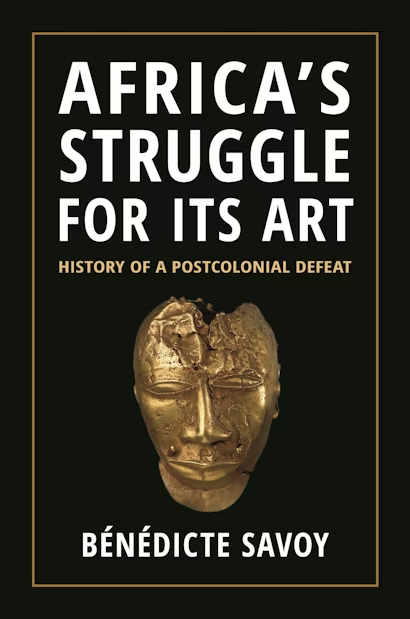For decades, African nations have fought for the return of countless works of art stolen during the colonial era and placed in Western museums. In Africa’s Struggle for Its Art, Bénédicte Savoy brings to light this largely unknown but deeply important history. One of the world’s foremost experts on restitution and cultural heritage, Savoy investigates extensive, previously unpublished sources to reveal that the roots of the struggle extend much further back than prominent recent debates indicate, and that these efforts were covered up by myriad opponents.
What prompted you to write Africa’s Struggle for its Art?
BS: The idea for the book emerged from the research I conducted in 2018 together with the Senegalese economist and writer Felwine Sarr on behalf of the French President Emmanuel Macron. While working on the report on the return of African art held in French museums, we discovered entire reams of documentation buried in administrative and press archives in Paris and Berlin. It became obvious that a detailed debate about collections from colonial contexts in European museums had already been held before, reaching its apex between 1978 and 1982. Archives matter - the reconstruction of the first restitution debate would not have been possible without the existence of generally accessible central archives with precise finding aids and user-friendly search systems. A surprising volume of material lurked under the carpet of oblivion.
There is dire need to incorporate the present restitution debate in the longue durée of historical processes, in order to recognise the political, personal, administrative and ideological constellations, which have by now shaped the debate for half a century.
Why was African art not returned at the time?
BS: It almost happened. At the time of the earlier debate, African demands were actually restricted to very few objects. But museum circles went into defence mode after the UN restitution resolution of 1973, and different positions regarding restitution at the time were almost exclusively characterised by a fundamental and harsh rejection of claims from former colonised countries. The book cites many examples from Germany, but the same applies to the UK and France. To put it simply, museums also lie. As many protagonists in the museum administrations of the 1970s and ’80s candidly documented in publications until the mid-1970s or later in internal correspondence, they knew perfectly well that the great majority of the African objects in their collections stemmed from the colonial era. To quote a much-referenced letter from 1897 to the director of the Ethnologisches Museum Berlin, even in the context of injustice during colonial rule it was “quite difficult to obtain an object without using at least a little bit of force.” The museum strategy of evasion and subterfuge proved ultimately successful at the time - the debate fizzled.
Is this all about Africa? What about the Parthenon Marbles?
BS: The case is different, of course. If we are looking for similarities, there is this: for many years, it was said that there was no suitable museum in Greece to house the marbles, were they to be returned. The same argument was used in the debate about returning cultural objects to African countries. Of course, in 2009 a great modern museum then opened in Athens, the Acropolis Museum. In the 1980s, Greece also showed solidarity with African countries.
What happens when cultural objects are taken to different places? What happens when they later return?
BS: I have long researched what I call the translocation of cultural objects, that is their being removed from one place and taken to another. How do societies handle the absence after removal? How do they handle the presence of new arrivals in a different place? What are the effects at both ends? The result is a fascinating dialectics of absence and presence. For example, the material heritage of Cameroon that was taken to Germany through colonial violence created an absence in its place of origin. This absence impeded the development of knowledge and awareness about the country’s heritage in Cameroon. At the same time, Western museums often also lack knowledge and awareness about parts of their holdings, because these pieces were detached from their culture of origin. It is possible to explore a kind of collection history in reverse.
What about the present? And the future?
BS: I am delighted and excited to see the recent returns from the Musée du quai Branly- Jacques Chirac in Paris, seized in 1892 in what was then the Kingdom of Dahomey, to the Republic of Benin. It was a historic experience to be present both at their departure after a final exhibition in Paris and at their point of arrival in Benin, where they were greeted with great ceremony, but also real joy. For me, the importance of the moment was akin to that of the Fall of the Berlin Wall. I am looking forward to seeing further commitments being put into practice, such as Germany’s expressed intent to return the so-called Benin bronzes, which were originally looted by the British in Benin City (now in Nigeria) and were then dispersed on the art market. To play for time again, like in the 1970s, and to withhold the cultural heritage of humanity for the purposes of national self-assertion is not an option for the future.
Bénédicte Savoy is professor in the Department of Art History at the Technical University of Berlin and was professor at the Collège de France in Paris from 2016 to 2021. She is the coeditor of Translocations: Histories of Dislocated Cultural Assets; Acquiring Cultures: Histories of World Art on Western Markets; and The Museum Is Open: Towards a Transnational History of Museums. She is the author (with Felwine Sarr) of The Restitution of African Cultural Heritage: Toward a New Relational Ethics, known as the Sarr-Savoy Report. She lives in Berlin.

